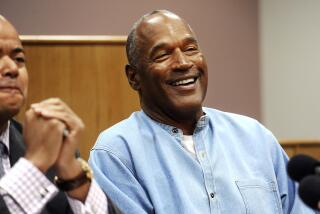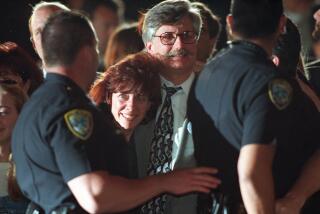A Winning Present on Father’s Day
- Share via
Joe Simpson wasn’t having the best of Father’s Days. His bad back was misbehaving. It was enough to keep him off the golf course, and that’s not easy to do.
Fortunately, Simpson had an enjoyable option that also involved the game of golf.
He would watch the U.S. Open on television. This was nice, because he had a rooting interest.
Joe’s son, Scott, was one shot off the lead as the day began at San Francisco’s Olympic Club. This position was not a whole lot more comfortable than Joe’s back, because the leader board also included such folks as Tom Watson, Seve Ballesteros, Ben Crenshaw and Bernhard Langer. What’s more, Jack Nicklaus and Greg Norman were close enough to be dangerous.
This Father’s Day would be a nerve-wracking.
Appropriately and perhaps surprisingly, the most relaxed member of the family was the one in the midst of the tumult at Olympic.
“Scott has tremendous self-control,” Joe said. “He keeps his cool and keeps the ball in play.”
While Scott was strolling across Olympic’s fairways as though oblivious to the growing consequence of every shot, his father watched from the family home in Kearny Mesa . . . and his mother, Char, paced.
“She watched and she walked, watched and walked, watched and walked,” Joe said. “She couldn’t sit still.”
Char laughed. Fortunately the house has a lot of doors, she said. She could get in and out and in and out and out and around.
“I felt like I walked 36 holes,” she said.
Joe Simpson, 57, a retired elementary school teacher, was not doing much walking. He was watching. He probably would have been watching even if his son had not been on the screen. After all, golf has been his game since . . .
OK, time for a confession. Golf has been Joe Simpson’s game since his honeymoon.
This may seem incongruous, and maybe even sound like grounds for a short-term marriage. But think about it. What better time to acquire a lifetime hobby than on the occasion of embarking upon a lifetime relationship? Besides, this was more a stay-at-home honeymoon in the aftermath of the Depression, and Char’s brother, Donald Van Giesen, was a party to this venture to the greensward.
“They both got jobs from 4 p.m. to 2 a.m. at the American Can Co.,” Char recalled. “What do you suppose they did during the day?”
This was in Wisconsin, before the Marine Corps “moved” the Simpsons to San Diego.
Joe fell for the game, and the game fell for him. He never took a lesson.
“I watched a lot of good players,” Simpson said. “My friends and I talked a lot about how to play, theories about how to swing and how to hold the club. I read golf magazines and golf books. I stood in front of a mirror and practiced my swing.”
His game became more a testimony to experimentation and hard work than to any of the gimmicky programs and instructional plans popular today. He reduced the game to its simplest form . . . or at least its simplest game plan. He determined it was a matter of hitting the ball onto the fairway, hitting it from there onto the green and then hoping a reasonable number of putts went in.
This is what everyone has in mind, but how many people can execute it?
Joe could. His walls and shelves are lined with certificates and trophies. It probably helped that the Marine Corps transferred him in 1953 to San Diego, where the game could be played 12 months a year.
This love of golf would be inherited by the Simpsons’ boys, Scott and Dave.
“I think Scott was 10 and Dave was 9 when I started them playing,” Simpson said. “I had already won a county match-play championship and a couple of club championships. They knew I was playing and practicing and bringing home trophies, and they wanted to try the game. I picked up a set of ladies’ irons and some junior woods and off we went.”
Dave, a certified public accountant in La Habra, was good. He won the Junior World championship at 14 and once shot 16-under for 72 holes at Balboa to win a San Diego junior title.
Scott was good, and would get a whole lot better. He won two NCAA championships at USC and has been a consistent money-winner since joining the PGA tour in 1979.
Scott Simpson was to hit golf’s pinnacle on Father’s Day of 1987.
It might have seemed appropriate that his father would have been there on such an occasion, except for a couple of things. He is a trumpet player as well as a golfer, and he had commitments both Saturday and Sunday nights. The back was a nuisance, of course, but the biggest factor keeping him home was probably his desire to see the tournament.
Joe Simpson has been around long enough to know the worst place to watch a golf tournament is on the course . . . particularly at a U.S. Open or Masters.
“The crowds are so bad you can’t see him hit a shot,” Simpson said. “I went to a Masters once and I couldn’t get near a green. I had to watch from 100 to 150 yards away. I couldn’t see him drive because I couldn’t get near a tee.”
And so Simpson watched his son walk the course and his wife pace the house. He watched as Scott birdied the 15th hole and Watson followed mere seconds later with a birdie on the 14th. When Scott also birdied the 16th hole, there was no echo, no answer, no equalizer from Watson.
Scott Simpson played the 17th and 18th holes as if Joe Simpson was whispering in his ear.
“Hit the ball in the fairway,” the voice would have said, “and then hit it on the green and then hit it close and then hit it in.”
That’s almost what Simpson did. He did have a minor misadventure with a bunker on 17, but escaped so splendidly his putt for par was still routine. He made sure he did not need a miracle, and Watson did. On this occasion, there was no miracle for Tom Watson.
Thus, Scott Simpson won the U.S. Open because he did what his father has always done. He reduced this complicated game to its most simple terms.
It made for a most pleasant Father’s Day, bad back and all.
More to Read
Go beyond the scoreboard
Get the latest on L.A.'s teams in the daily Sports Report newsletter.
You may occasionally receive promotional content from the Los Angeles Times.






